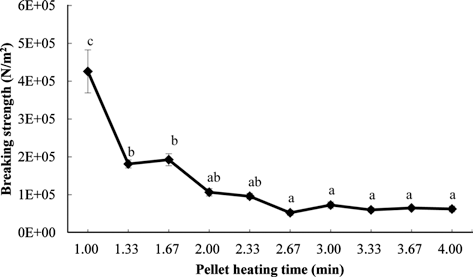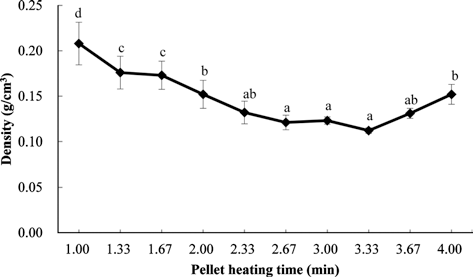Introduction
Yukwa, a Korean traditional oil-puffed snack made of steeping waxy rice, has long been consumed as a popular snack due to its soft texture and unique taste. The quality of traditional Yukwa depends on the process conditions, such as the steeping period of the waxy rice, milling method, conditions of pounding, drying and frying (Shin et al., 1990). However, it contains high amount of fat, which is harmful for human health. Therefore, there is a need to develop non-deepfried Yukwa products and to increase consumer interests in eating these Yukwa products.
Non-deep-fried Yukwa has been explored using convection oven method (Lee et al., 2008), microwave oven method (Choi et al., 2000; Lee et al., 2008), far infrared ray electrical roaster method (Yang et al., 2008) and air puffing method (Shin et al., 1990). Yukwa made from vacuum puffing process has also been studied in recent years. Yu & Ryu (2010) suggested that the optimum condition of vacuum puffing machine for the production of vacuum-puffed Yukwa was 120 ° C heating temperature, 4 min preheating time and 5 min puffing time. With vacuum-puffing conditions of 3 min heating time and 2 min puffing time, pellets with about 25% moisture content showed higher expansion ratio, lower density and lower breaking strength (Shen et al., 2011). Moreover, with vacuum-puffing conditions of 3 min heating time and 2 min puffing time, extruded pellets (Shen et al., 2013) and pellets added with green tea powder (Shen et al., 2014) were successfully puffed and studied.
During vacuum puffing, the machine heats the waxy rice pellet and generates superheated steam creating high internal pressure inside the pellet. This causes the expansion of product and forms a porous structure. The driving force for expansion has been hypothesized to be the vaporization of water which generates the superheated steam necessary for expansion (Altan, 2014). During heating, starch matrix in the presence of water undergoes a phase transition from a glassy to a rubbery state that allows expansion and formation of the final structure (Boischot et al., 2003). The degree of gelatinization affected the puffing as in case of the heating time before vacuum puffing. At sufficient moisture and elevated temperature, hydrothermal treatment resulted in changes of rice starch like granule swelling, loss of birefringence and disruption of starch granule (Lai & Cheng, 2004). Modification of starch using different pretreatments before microwave expansion leads to a better quality product. However, few investigated the influence of pellet heating time in the vacuum puffing machine on the characteristics of vacuum-puffed Yukwa. Therefore, the objective of this study was to investigate the effects of pellet heating time on physical properties of vacuum-puffed Yukwa, and to optimize the manufacturing process of vacuum-puffed Yukwa.
Materials and Methods
Waxy rice, obtained from a commercial source in Korea, was washed and steeped in water at 30 ° C for 3 days. After draining for 12 h over a sieve, the waxy rice was pulverized with a roll mill (Sinpoong ENG. Ltd., Daegu, Korea) for two times and stored in a refrigerator at 2 ° C until use.
The milled waxy rice was steamed for 60 min by using a steam cooker (Daechang stainless ENG. Ltd., Seoul, Korea), then the resulting dough was punched at mode 3 for 15 min with a KM 400 screw kneader (KENWOOD Ltd., London, UK). After cooling at 2 ° C for 3 h, the dough was cut into small pieces with an average dimension of approximately 4 cm × 1 cm × 0.5 cm (length × width × thickness) and dried in a hot air oven at 50 ° C for 6.5 h. The dried pellets (called bandegi) were kept at 2 ° C for 2 d before puffing by vacuum puffing machine. Before 2 min puffing time, the vacuum puffing process was performed at heating time of 1.00, 1.33, 1.67, 2.00, 2.33, 2.67, 3.00, 3.33, 3.67, 4.00 min.
Expansion ratio was determined by the volume ratio of vacuum-puffed Yukwa and pellets. The volume of vacuumpuffed Yukwa and pellets was determined using a seed displacement method. Each essay was the mean of 10 repetitions.
ER: Expansion ratio
Vy: Volume of vacuum-puffed Yukwa
Vp: Volume of pellet
Density of expanded pellets was determined using the seed displacement method with millet seed. Density of the vacuumpuffed Yukwa was calculated by dividing its determined volume by the mass. Mean of 10 repetitions from each test was used to Calculate the average value.
ρy: Density of vacuum-puffed Yukwa (g/cm 3 )
ρm: Density of millet (g/cm 3 )
M: Mass of Yukwa (g)
Mm: Mass of millet in cup (g)
Ml: Mass of millet and Yukwa in cup (g)
The texture of vacuum-puffed Yukwa was evaluated using the Sun Rheometer (Compac-100 II, Sun Sci. Co., Tokyo, Japan). After setting the vacuum-puffed Yukwa on top of 2 cm wide platform, the sharp-edged probe (0.01 mm) was lowered at a speed of 120 mm/min with a 10-kg load cell. The breaking strength was calculated. The results were the average of 10 measurements.
Fbr: Breaking strength (N/m 2 )
Fm: Maximum force during the cutting of vacuum-puffed Yukwa (N/m 2 )
S: Cross-sectional area of vacuum-puffed Yukwa (m 2 )
The darkest points of the surfaces of vacuum-puffed Yukwa were measured using a Chroma meter (CR-300, Minolta, Osaka, Japan). The color parameters L (black to white), a (redness to greenness), b (yellowness to blueness) were recorded separately. Each essay was the mean of ten repetitions.
Results and Discussion
Correlation coefficients between pellet heating time and physical properties of vacuum-puffed Yukwa were shown in Table 1. Pellet heating time was well correlated with expansion ratio (r = 0.509, p<0.01), density (r = -0.554, p<0.01), breaking strength (r=-0.702, p<0.01), color L (r=-0.213, p<0.01), color a (r=0.746, p<0.01), and color b (r=0.836, p<0.01). Expansion ratio was inversely related to density (r=- 0.731, p<0.01) and breaking strength (r=-0.588, p<0.01), while density was positively correlated to breaking strength (r=0.531, p<0.01). High expansion led to low density and breaking strength. As indicated by Limón-Valenzuela et al (2010), products with a higher expansion formed bubbles of air with thin walls, resulting low cutting forces. High density product naturally offers high hardness evident by high correlation between product density and hardness. Increase in expansion resulted in pores in the structure due to formation of air cells and the surface appeared porous and hence decreased hardness (Altan, 2014). On the other hand, color L was inversely related t° Color a (r=-0.321, p<0.01) and color b (r=- 0.218, p<0.01), while color a was positively correlated to Color b (r=0.806, p<0.01). Similar results were also reported by Ascheri et al. (1995) and Shen et al. (2013).
. 1 showed the appearance of vacuum-puffed Yukwa influenced by pellet heating time. Similar with the results of Shen et al. (2011), some burnt points and irregular surface shrinkage were found on the surfaces of Yukwa samples. The negative effect of extending the pellet heating time was the darker burnt points in the surface of Yukwa samples.

Color values affected by pellet heating time were given in Table 2. Significant differences (p<0.05) were found in color values of vacuum-puffed Yukwa obtained at different pellet heating time. Depending on different pellet heating time, color values ranged from 74.73 to 80.68 for lightness, 0.04 to 6.88 for redness, and 3.52 to17.56 for yellowness. The highest a value (6.88) and b value (17.56) were obtained at pellet heating time of 4.00 min. The increase in pellet heating time tended to the decrease in redness of vacuum-puffed Yukwa. Extending pellet heating time increased the yellowness of all products, except 3 min heating time. The more expanded product would give more bright color due to air cells rather than dull color (Altan et al., 2008). The increase in redness of samples prepared by autoclaving or combination method may be resulted from occurrence of brown reaction due to polymerization of endogenous phenolic compounds during autoclaving and from Maillard reaction during infrared and microwave heating (Baik & Ullrich, 2008)
Fig. 2 showed the expansion ratio of vacuum-puffed Yukwa affected by pellet heating time. The expansion ratio of vacuumpuffed Yukwa significantly increased as the pellet heating time increased from 1.00 to 3.33 min, but decreased significantly when the pellet heating time was over 3.33 min. The lowest expansion ratio (2.95) was obtained from pellet heating time of 1.00 min. No significant difference was found on expansion ratio of vacuum-puffed Yukwa when pellet heating time was 2.33, 2.67, 3.00 and 3.67 min, respectively. The increase in expansion may be attributed to gelatinization that occurred during the heating of waxy rice pellet. As the heating time increased, more energy is obtained for starch gelatinization. Short residence time in the vacuum puffing machine probably does not allow the waxy rice pellet to Complete gelatinization. Meanwhile, at longer heating time, the waxy rice pellet would be too hard and thus this would prevent the sudden vapor pressure release and caused decrease in expansion. Similar reports on barley microwave puffing were also observed by Altan (2014).

Density is a parameter that is controlled by the degree of expansion and is measured routinely for quality control purposes. Density of vacuum-puffed Yukwa ranged from 0.006 to 0.047 g/cm 3 . The heating in the vacuum puffing machine caused the evaporation of water which built up pressure inside the waxy rice pellet and this caused expansion of the waxy rice pellet creating a porous structure. There was a significant effect of the pellet heating time on bulk density of vacuum-puffed Yukwa. The lowest bulk density value (0.112 g/cm 3 ) was obtained at 3.33 min heating time, whereas the highest value (0.208 g/cm 3 ) was obtained at 1 min. The density of vacuumpuffed Yukwa significantly decreased as the pellet heating time increased from 1.00 to 3.33 min, but increased significantly when the pellet heating time was over 3.33 min. The bubble growth, which was driven by the pressure difference between the interior of the growing bubble and atmospheric pressure resisted by the viscosity of the bubble wall, dominated the density at longer pellet heating time. This was agreed with the study on rice-based expanded snacks from Ding et al. (2005).
The breaking strength of vacuum-puffed Yukwa is a perception of the human being and is associated with expansion and cell structure of the product (Meng et al., 2010). The effect of the pellet heating time on the breaking strength of vacuum-puffed Yukwa is illustrated in Fig. 4. The breaking strength of vacuumpuffed Yukwa varied between 5.22E + 04 and 4.26E + 05. The breaking strength of vacuum-puffed Yukwa at 1 min heating time was significantly higher than that of other products indicating the extent of structural changes. This may be due to the rheological behavior of the waxy rice pellet influenced by pellet heating time. Short heating time probably does not allow the pellet to Complete gelatinization, resulting in hard texture of Yukwa products. The breaking strength tended to decrease as the pellet heating time increased. The lowest breaking strength was obtained at 2.67 min heating time. Similar reports were also reported by Altan (2014).

Conclusions
An acceptable vacuum-puffed Yukwa snack can be produced by changing the waxy rice pellet heating time in the vacuum puffing machine. The results demonstrated that the physical properties of vacuum-puffed Yukwa were strongly influenced by the pellet heating time. The work made it clear that the waxy rice pellet should be heated for 3.33 min when the moisture content was 25%. Overall, vacuum puffing method can be used as a promising alternative method for Yukwa production by optimizing its manufacturing process.
